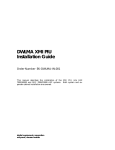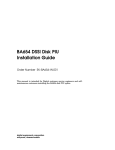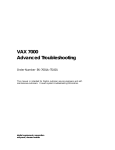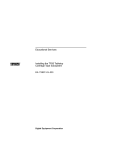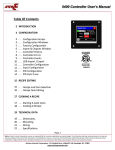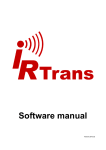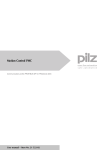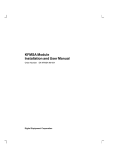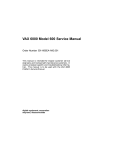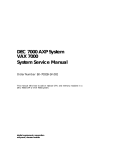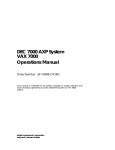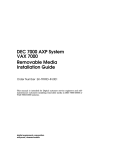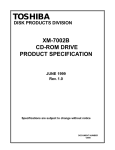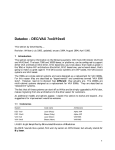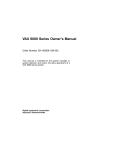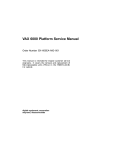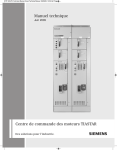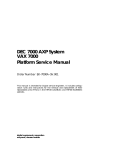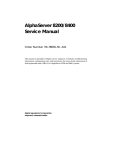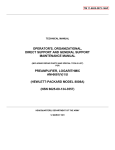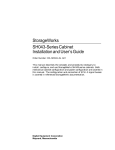Download DEC 7000 AXP, VAX 7000 Site Preparation Guide
Transcript
DEC 7000 AXP System VAX 7000 Site Preparation Guide Order Number EK–7000B–SP.002 This guide is intended for use by Digital customer service engineers and customers in preparing a site for a DEC 7000 AXP system or VAX 7000 system. digital equipment corporation maynard, massachusetts First Printing, November 1992 The information in this document is subject to change without notice and should not be construed as a commitment by Digital Equipment Corporation. Digital Equipment Corporation assumes no responsibility for any errors that may appear in this document. The software, if any, described in this document is furnished under a license and may be used or copied only in accordance with the terms of such license. No responsibility is assumed for the use or reliability of software or equipment that is not supplied by Digital Equipment Corporation or its affiliated companies. Copyright © 1992 by Digital Equipment Corporation. All Rights Reserved. Printed in U.S.A. The following are trademarks of Digital Equipment Corporation: Alpha AXP AXP DEC DECchip DEC LANcontroller DECnet DECUS DWMVA OpenVMS ULTRIX UNIBUS VAX VAXBI VAXELN VMScluster XMI The AXP logo dT OSF/1 is a registered trademark of the Open Software Foundation, Inc. FCC NOTICE: The equipment described in this manual generates, uses, and may emit radio frequency energy. The equipment has been type tested and found to comply with the limits for a Class A computing device pursuant to Subpart J of Part 15 of FCC Rules, which are designed to provide reasonable protection against such radio frequency interference when operated in a commercial environment. Operation of this equipment in a residential area may cause interference, in which case the user at his own expense may be required to take measures to correct the interference. Contents Preface ....................................................................................................... v Chapter 1 Site Preparation 1.1 1.2 1.3 1.4 1.5 Pre-Installation Checklist ..................................................... 1-2 Cabinet Sizes .......................................................................... 1-4 Floor Space and Environmental Requirements ................... 1-6 Power Requirements .............................................................. 1-8 AC Power Cable and Receptacles ........................................ 1-10 Figures 1-1 1-2 1-3 1-4 Sample System ....................................................................... 1-4 Sample Configuration ............................................................ 1-6 Power System Components ................................................... 1-8 AC Power Receptacles .......................................................... 1-10 Tables 1 2 1-1 1-2 1-3 1-4 1-5 DEC 7000/VAX 7000 Documentation .................................... vii Related Documents .................................................................. ix Shipping Dimensions and Weights ....................................... 1-3 Cabinet Dimensions and Weights ......................................... 1-5 Environmental Specifications ............................................... 1-7 AC Input Voltages .................................................................. 1-9 Power Requirements .............................................................. 1-9 iii iv Preface Intended Audience This manual is written for Digital customer service engineers and customers preparing a site for a DEC 7000 or VAX 7000 system. Document Structure This manual uses a structured documentation design. Topics are organized into small sections for efficient on-line and printed reference. Each topic begins with an abstract. You can quickly gain a comprehensive overview by reading only the abstracts. Next is an illustration or example, which also provides quick reference. Last in the structure are descriptive text and syntax definitions. This manual has one chapter, as follows: • Chapter 1, Site Preparation, provides pre-installation requirements and guidelines for DEC 7000 and VAX 7000 systems. v Conventions Used in This Document Terminology. Unless specified otherwise, the use of "system" refers to either a DEC 7000 AXP or VAX 7000 system. The DEC 7000 AXP systems use the Alpha AXP architecture. References in text use DEC 7000 to refer to DEC 7000 AXP systems. When a discussion applies to only one system, an icon is used to highlight that system. Otherwise, the discussion applies to both systems. Thus, the abstract for a module that applies only to DEC 7000 systems would look like this: This section shows a sample boot of OpenVMS Alpha AXP DEC from the RRD42 CD drive for DEC 7000 systems. The first 7000 step is issuing the show device command to determine the location of the RRD42. Book titles. In text, if a book is cited without a product name, that book is part of the hardware documentation. It is listed in Table 1 along with its order number. Icons. The icons shown below are used in illustrations for designating part placement in the system described. A shaded area in the icon shows the location of the component or part being discussed. Front Rear Documentation Titles Table 1 lists the books in the DEC 7000 and VAX 7000 documentation set. Table 2 lists other documents that you may find useful. vi Table 1 DEC 7000/VAX 7000 Documentation Title Order Number Installation Kit EK–7000B–DK Site Preparation Guide EK–7000B–SP Installation Guide EK–700EB–IN Hardware User Information Kit EK–7001B–DK Operations Manual EK–7000B–OP Basic Troubleshooting EK–7000B–TS Service Information Kit—VAX 7000 EK–7002A–DK Platform Service Manual EK–7000A–SV System Service Manual EK–7002A–SV Pocket Service Guide EK–7000A–PG Advanced Troubleshooting EK–7001A–TS Service Information Kit—DEC 7000 EK–7002B–DK Platform Service Manual EK–7000A–SV System Service Manual EK–7002B–SV Pocket Service Guide EK–7700A–PG Advanced Troubleshooting EK–7701A–TS vii Table 1 DEC 7000/VAX 7000 Documentation (Continued) Title Order Number Reference Manuals Console Reference Manual EK–70C0B–TM KA7AA CPU Technical Manual EK–KA7AA–TM KN7AA CPU Technical Manual EK–KN7AA–TM MS7AA Memory Technical Manual EK–MS7AA–TM I/O System Technical Manual EK–70I0A–TM Platform Technical Manual EK–7000A–TM Upgrade Manuals KA7AA CPU Installation Guide EK–KA7AA–IN KN7AA CPU Installation Guide EK–KN7AA–IN MS7AA Memory Installation Guide EK–MS7AA–IN KZMSA Adapter Installation Guide EK–KXMSX–IN DWLMA XMI PIU Installation Guide EK–DWLMA–IN DWMBB VAXBI PIU Installation Guide EK–DWMBB–IN H7237 Battery PIU Installation Guide EK–H7237–IN H7263 Power Regulator Installation Guide EK–H7263–IN BA654 DSSI Disk PIU Installation Guide EK–BA654–IN BA655 SCSI Disk and Tape PIU Installation Guide EK–BA655–IN Removable Media Installation Guide EK–TFRRD–IN viii Table 2 Related Documents Title Order Number General Site Preparation Site Environmental Preparation Guide EK–CSEPG–MA System I/O Options BA350 DECstor/me Modular Storage Shelf Subsystem Configuration Guide EK–BA350–CG BA350 DECstor/me Modular Storage Shelf Subsystem User’s Guide EK–BA350–UG BA350-LA DECstor/me Modular Storage Shelf User’s Guide EK–350LA–UG CIXCD Interface User Guide EK–CIXCD–UG DEC FDDIcontroller 400 Installation/Problem Solving EK–DEMFA–IP DEC LANcontroller 400 Installation Guide EK–DEMNA–IN DEC LANcontroller 400 Technical Manual EK–DEMNA–TM DSSI VAXcluster Installation and Troubleshooting Manual EK–410AA–MG InfoServer 150 Installation and Owner’s Guide EK–INFSV–OM KDM70 Controller User Guide EK–KDM70–UG KFMSA Module Installation and User Manual EK–KFMSA–IM KFMSA Module Service Guide EK–KFMSA–SV RRD42 Disc Drive Owner’s Manual EK–RRD42–OM RF Series Integrated Storage Element User Guide EK–RF72D–UG TF85 Cartridge Tape Subsystem Owner’s Manual EK–OTF85–OM TLZ06 Cassette Tape Drive Owner’s Manual EK–TLZ06–OM ix Table 2 Related Documents (Continued) Title Order Number Operating System Manuals Alpha Architecture Reference Manual EY–L520E–DP DEC OSF/1 Guide to System Administration AA–PJU7A–TE DECnet for OpenVMS Network Management Utilities AA–PQYAA–TK Guide to Installing DEC OSF/1 AA–PS2DA–TE OpenVMS Alpha Version 1.0 Upgrade and Installation Manual AA–PQYSA–TE VMS Upgrade and Installation Supplement: VAX 7000–600 and VAX 10000–600 Series AA–PRAHA–TE VMS Network Control Program Manual AA–LA50A–TE VMSclusters and Networking HSC Installation Manual EK–HSCMN–IN SC008 Star Coupler User’s Guide EK–SC008–UG VAX Volume Shadowing Manual AA–PBTVA–TE Peripherals x Installing and Using the VT420 Video Terminal EK–VT420–UG LA75 Companion Printer Installation and User Guide EK–LA75X–UG Chapter 1 Site Preparation This chapter provides site planning guidelines, cabinet sizes, space and environmental requirements, and system power requirements. Sections include: • Pre-Installation Checklist • Cabinet Sizes • Floor Space and Environmental Requirements • Power Requirements • AC Power Cable and Connectors Site Preparation 1-1 1.1 Pre-Installation Checklist Site planning guidelines and tasks are listed below. The tasks can be checked off when completed before system delivery. To facilitate the installation process, it is recommended that the customer plan ahead and coordinate the site planning and scheduling details with Digital. Planning the Site: b b b b b b b b b b 1-2 Plan the physical layout of the system cabinet, expander cabinets, console terminal, and other system units. Plan to place all equipment away from heavy traffic centers leaving enough room for airflow and maintenance. Obtain cabinet weights and dimensions to check against floor loading restrictions. Determine the sizes of circuit breakers and the number of branch circuits required. Determine number, type, and location of required AC power outlets. Check the compatibility of different power sources. This must be checked when multiple types of power distribution transformers, or power conditioning equipment is used. Determine system power consumption to calculate the input line power requirement. Establish a system grounding scheme for the installation. Determine environmental cooling requirements. Check the location and requirements of cabling for communication devices such as Ethernet. Site Preparation Checking the Delivery Route: b b b b Check the height, width, and location of doors and passageways for adequate clearance. Check floor loading requirements along passageways. Check passageway restrictions such as corners, ramps, or obstructions. Check the size, capacity, and availability of elevators. Table 1-1 lists the shipping dimensions for the system and expander cabinets. These dimensions include the width of the shipping pallet, the height of the shipping boxes, and the weight of the packing materials. Table 1-1 Shipping Dimensions and Weights Cabinet Height cm (in) Width cm (in) Depth cm (in) Weight 1 kg (lbs) System 195 (76.8) 109.5 (43.1) 121 (47.5) 448 (1000) System (Battery PIU with four batteries)2 195 (76.8) 109.5 (43.1) 121 (47.5) 585 (1300) Expander 195 (76.8) 109.5 (43.1) 121 (47.5) 495 (1100) Expander (with four batteries)2 195 (76.8) 109.5 (43.1) 121 (47.5) 632 (1393) 1 Weights are based on a fully configured cabinet. 2 For systems with 8 batteries add 62 kg (137 lbs) and for systems with 12 batteries add 124 kg (274 lbs). For more information: Site Environmental Preparation Guide Site Preparation 1-3 1.2 Cabinet Sizes Include all cabinets and peripherals when laying out the installation site. A sample system could include a main cabinet, a maximum of two expander cabinets, and console devices. Figure 1-1 Sample System 170 cm (67 in) Expander Cabinet 170 cm (67 in) System Cabinet 170 cm (67 in) Expander Cabinet 80 cm (31.5 in) 80 cm (31.5 in) 80 cm (31.5 in) BXB-0001B-92 1-4 Site Preparation Table 1-2 Cabinet Dimensions and Weights Cabinet Height cm (in) Width cm (in) Depth cm (in) Weight 1 kg (lbs) System 170 (67) 80 (31.5) 87.5 (34.5) 408 (900) System (Battery PIU with four batteries)2 170 (67) 80 (31.5) 87.5 (34.5) 545 (1200) Expander 170 (67) 80 (31.5) 87.5 (34.5) 448 (1000) Expander (with four batteries)2 170 (67) 80 (31.5) 87.5 (34.5) 585 (1300) 1 Weights are based on a fully configured cabinet. 2 For systems with 8 batteries add 62 kg (137 lbs) and for systems with 12 batteries add 124 kg (274 lbs). Site Preparation 1-5 1.3 Floor Space and Environmental Requirements Table 1-3 lists system environmental requirements. Front and rear clearance specifications are the minimum space required for airflow and maintenance. Figure 1-2 Sample Configuration Rear Clearance 100 cm (39 in) Expander Cabinet System Cabinet Width 240 cm (94.5 in) Expander Cabinet 87.5 cm (34.5 in) Depth 337.5 cm (132 in) Front Clearance 150 cm (59 in) BXB-0001A-92 NOTE: Do not place anything on the top of the cabinets, as this restricts airflow. The console terminal and printer can be placed on a table near the system. 1-6 Site Preparation Table 1-3 Environmental Specifications Environmental Operating Storage Temperature1 15°–28° C (59°–82° F) -40°–66° C (-40°–151° F) Relative humidity1 20–80% 10–95% Altitude 0–2.4 km (0–8000 ft) 0–9.1 km (0–30,000 ft) 1Recommended operating temperature is 18°–24° C (65°–75° F) and 40–60% relative humidity. The minimum amount of clearance space for the system front is 150 cm (59 in) and rear is 100 cm (39 in), as shown in Figure 1-2. These clearances are needed for airflow and maintenance. Airflow Air is taken in through the top and bottom of the cabinet by a dual wheel blower. The air is then circulated through the card cages and power regulators. It is vented at the middle of the cabinet front and rear. NOTE: Inadequate airflow can result in the system shutting down, For more information: Site Environmental Preparation Guide Site Preparation 1-7 1.4 Power Requirements The power system includes an AC input box, DC distribution box, power regulators, cabinet control logic (CCL) module, optional 48V batteries, power distribution cables, and signal interconnect cables. Figure 1-3 Rear Power System Components CCL Module Front AC Input Box DC Distribution Box Power Regulators BXB-0052-92 1-8 Site Preparation Table 1-4 AC Input Voltages Country Input Voltage Circuit Breaker 1 Rating (amps) Frequency Range (Hz) Japan 202 Delta 30 50–60 North America 120/208 Wye 30 50–60 Europe/GIA 380–415 Wye 16 50–60 1Each system and expander cabinet requires its own AC power connector. Table 1-5 Power Requirements Cabinet Power (watts) Heat Dissipation (BTU/hr) System 1,000 minimum1 5,200 maximum2 3,400 minimum1 17,700 maximum2 System and 2 expanders 13,800 maximum2 47,000 maximum2 1A minimum configuration consists of one CPU module, one memory module, one IOP module, one XMI PIU, one Ethernet I/O bus adapter module, and one disk I/O bus adapter module. 2These requirements are based on a fully loaded system. NOTE: AC power receptacles are also required for console terminals and printers. Site Preparation 1-9 1.5 AC Power Cable and Receptacles The AC power cable is 2.8 m (9 ft) in length. It consists of threephase leads (X, Y, and Z) plus neutral (N) and ground (G). AC power connectors are shown in Figure 1-4. NOTE: Neutral and ground lines must both be connected from the bulk three-phase power to complete the Wye configuration. Otherwise, power components may be damaged. Do not power up the system until power checks are completed. Figure 1-4 AC Power Receptacles 202 V NOMINAL (50-60 Hz) NEMA L21-30R 120/208 V NOMINAL (50-60 Hz) NEMA L21-30R V V V V PHASE X PHASE X PHASE Y PHASE Y NEUTRAL GND GND PHASE Z PHASE Z V V 380-415 V NOMINAL (50-60 Hz) IEC 309 TYPE V V PHASE 3 PHASE 2 NEUTRAL PHASE 1 GND V BXB-0040A-92 1-10 Site Preparation Index A G AC current ratings, 1-9 AC input voltages, 1-9 AC power cables, 1-10 AC power connectors, 1-10 AC power outlets, 1-2 Air circulation, 1-7 Altitude, 1-7 Grounding, 1-2 B Operating characteristics, 1-7 Backup batteries, 1-8 Branch circuits, 1-2 P C Cabinet sizes, 1-4 Cables signal interconnect, 1-8 Communications devices, 1-2 D DC distribution box, 1-8 Delivery route checking, 1-3 E H Heat dissipation, 1-9 Humidity, 1-7 O Power distribution cables, 1-8 requirements, 1-8 sources, 1-2 watts, 1-9 Pre-installation checklist, 1-2 R Rear clearance, 1-6 S F Shipping dimensions, 1-3 weights, 1-3 Site circuit breakers, 1-2 Site planning guidelines, 1-2 System cabinet specifications, 1-5 Floor space, 1-6 Front clearance, 1-6 T Environmental specifications, 1-7 Expander cabinet specifications, 1-5 Temperature, 1-7 Index-1





















